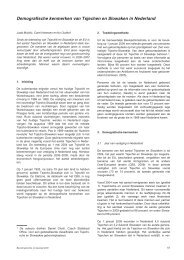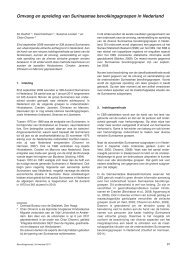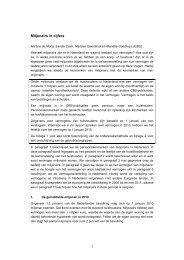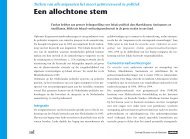Babyboomers in the Netherlands: What the statistics say - Cbs
Babyboomers in the Netherlands: What the statistics say - Cbs
Babyboomers in the Netherlands: What the statistics say - Cbs
Create successful ePaper yourself
Turn your PDF publications into a flip-book with our unique Google optimized e-Paper software.
Baby boomers<br />
<strong>in</strong> <strong>the</strong> Ne<strong>the</strong>rlands<br />
<strong>What</strong> <strong>the</strong> <strong>statistics</strong> <strong>say</strong>
Foreword<br />
Nearly 14 million babies have been born <strong>in</strong> <strong>the</strong> Ne<strong>the</strong>rlands<br />
s<strong>in</strong>ce <strong>the</strong> Second World War; 2.4 million of <strong>the</strong>m<br />
<strong>in</strong> <strong>the</strong> period 1946–1955: <strong>the</strong> baby boom generation.<br />
The number of births <strong>in</strong> <strong>the</strong> Ne<strong>the</strong>rlands rema<strong>in</strong>ed<br />
high until <strong>the</strong> end of <strong>the</strong> 1960s. Dutch post-war<br />
population growth was unique <strong>in</strong> western Europe.<br />
Although births peaked <strong>in</strong> o<strong>the</strong>r countries <strong>in</strong> western<br />
Europe after <strong>the</strong> war, until <strong>the</strong> mid-1950s nowhere was<br />
it as high as <strong>in</strong> <strong>the</strong> Ne<strong>the</strong>rlands.<br />
The consequences of <strong>the</strong> enormous birth wave were farreach<strong>in</strong>g:<br />
overcrowded primary school classes <strong>in</strong> <strong>the</strong><br />
1950s, an <strong>in</strong>flux on <strong>the</strong> labour market and <strong>in</strong> higher<br />
education <strong>in</strong> <strong>the</strong> 1960s, a construction frenzy <strong>in</strong> <strong>the</strong> 1970s,<br />
and a surge <strong>in</strong> <strong>the</strong> number of over-65s from 2011 onwards.<br />
The first batch of baby boomers, born <strong>in</strong> 1946, received<br />
<strong>the</strong>ir first state pension <strong>in</strong> March and April 2011. Their<br />
retirement caused a sharp rise <strong>in</strong> <strong>the</strong> number of state<br />
pensions. While <strong>the</strong> number of pensions paid rose by just<br />
over 7 thousand <strong>in</strong> February 2011, <strong>in</strong> March to May 2011 it<br />
rose by at least 14 thousand a month.<br />
Today’s 55–64 year-olds have relatively low levels of<br />
education compared with younger generations: no more<br />
than a quarter have a degree <strong>in</strong> higher education. They<br />
are relatively prosperous on <strong>the</strong> o<strong>the</strong>r hand: <strong>the</strong>y are at<br />
<strong>the</strong> peak of <strong>the</strong>ir careers, have relatively high <strong>in</strong>comes<br />
and have built up a substantial capital.<br />
In <strong>the</strong> com<strong>in</strong>g years, <strong>the</strong> Dutch population will comprise<br />
200 thousand new 65 year-olds every year. The net<br />
<strong>in</strong>crease <strong>in</strong> <strong>the</strong> total number of over-65s will be smaller,<br />
though, as some die and o<strong>the</strong>rs emigrate.<br />
They will enjoy a relatively long even<strong>in</strong>g of <strong>the</strong>ir lives as<br />
well: a man born <strong>in</strong> 1946 who lives to celebrate his 65th<br />
birthday can expect to live for ano<strong>the</strong>r n<strong>in</strong>eteen years.<br />
Clearly, <strong>the</strong> economy <strong>in</strong> <strong>the</strong> com<strong>in</strong>g years will focus more<br />
on <strong>the</strong> services and care <strong>in</strong>dustries.<br />
This book gives an impression of <strong>the</strong> <strong>in</strong>fluence of this<br />
post-war generation on Dutch society. As well as look<strong>in</strong>g<br />
at <strong>the</strong>ir situation today, it looks back at <strong>the</strong>ir past and<br />
forward to <strong>the</strong>ir future.<br />
To compile this picture of <strong>the</strong> baby boom generation, <strong>the</strong><br />
author used material from <strong>the</strong> StatL<strong>in</strong>e database<br />
(statl<strong>in</strong>e.cbs.nl) and from <strong>the</strong> extensive library of Statistics<br />
Ne<strong>the</strong>rlands. More <strong>statistics</strong> can be found on <strong>the</strong> website<br />
of Statistics Ne<strong>the</strong>rlands (www.cbs.nl).<br />
Director-General of Statistics Ne<strong>the</strong>rlands<br />
G. van der Veen<br />
The Hague/Heerlen, April 2012
Contents<br />
1 Prolific war marriages 6<br />
2 New life courses 9<br />
3 Stay<strong>in</strong>g <strong>in</strong> and go<strong>in</strong>g out 13<br />
4 Hedonistic youth 16<br />
5 Row on row of terraced houses 20<br />
6 Low educated, but prosperous 24<br />
7 Older workers will<strong>in</strong>g to stay on 28<br />
8 Retirement 31<br />
9 More than 3 million state pensions 35<br />
10 Dutch population relatively young 38<br />
11 Ripples of a birth wave 42<br />
References 45
1<br />
Prolific<br />
war marriages<br />
Some 2.4 million babies were born <strong>in</strong> <strong>the</strong> Ne<strong>the</strong>rlands <strong>in</strong> <strong>the</strong><br />
period 1946–1955. These are <strong>the</strong> babies we def<strong>in</strong>e as <strong>the</strong><br />
belong<strong>in</strong>g to <strong>the</strong> post-war baby boom. The rise <strong>in</strong> <strong>the</strong> number<br />
of births started earlier, however: <strong>in</strong> 1943–1945 Dutch<br />
marriages also proved very fertile. Population growth<br />
rema<strong>in</strong>ed high <strong>in</strong> <strong>the</strong> country until <strong>the</strong> end of <strong>the</strong> 1960s.<br />
Accord<strong>in</strong>g to Statistics Ne<strong>the</strong>rlands’ demograph ers (1989),<br />
<strong>the</strong> birth wave <strong>in</strong> <strong>the</strong> years imme diately after <strong>the</strong> Second<br />
World War was caused by expecta tions that <strong>the</strong> war would<br />
end quickly after <strong>the</strong> Normandy <strong>in</strong>vasion by <strong>the</strong> western<br />
allied forces <strong>in</strong> June 1944.<br />
A quick first baby…<br />
The large numbers of baby boom births <strong>in</strong> <strong>the</strong> period<br />
1946–1949 were not <strong>the</strong> result of a real <strong>in</strong>crease <strong>in</strong> fertility.<br />
The average number of children per woman even fell <strong>in</strong><br />
<strong>the</strong> longer term. The protracted post-war birth wave was<br />
caused by more people gett<strong>in</strong>g married, and at younger<br />
ages, comb<strong>in</strong>ed with <strong>the</strong> wish to realise <strong>the</strong> desired<br />
number of children as quickly as possible after marriage,<br />
especially of couples marry<strong>in</strong>g <strong>in</strong> <strong>the</strong> last years of <strong>the</strong> war.<br />
The sharp drop <strong>in</strong> age at first birth, by more than two<br />
years, for pre-war generations of women illustrates this:<br />
women born between 1920 and 1940 married at younger<br />
ages, and also had <strong>the</strong>ir first baby at younger ages.
… soon followed by a sibl<strong>in</strong>g<br />
The high fertility <strong>in</strong> marriage cohort 1944 is thus <strong>the</strong><br />
result of <strong>the</strong> quick birth of a child with<strong>in</strong> <strong>the</strong> first year<br />
of marriage, but also <strong>the</strong> rapid birth of a second child <strong>in</strong><br />
<strong>the</strong> second year of marriage. Statisticians cited <strong>the</strong><br />
prospect of ‘<strong>the</strong> war tak<strong>in</strong>g a turn for <strong>the</strong> better’ as <strong>the</strong><br />
reason for this fertility behaviour. In <strong>the</strong> first months of<br />
1945, <strong>in</strong> particular, many children were born <strong>in</strong> <strong>the</strong>se<br />
marriages.<br />
Couples who married <strong>in</strong> <strong>the</strong> years 1937–1945 ultimately<br />
produced 3.1 children on average. After three years of<br />
marriage, <strong>the</strong>y had 1.1 children on average. Couples<br />
marry<strong>in</strong>g <strong>in</strong> 1943–1945, were more fertile: <strong>the</strong>y already<br />
had 1.3 children on <strong>the</strong>ir third anniversary. Accord<strong>in</strong>g to<br />
Statistics Ne<strong>the</strong>rlands, this higher fertility was <strong>the</strong><br />
result of ‘a higher number of conceptions as a result of<br />
<strong>the</strong> favourable prospects offered by <strong>the</strong> <strong>in</strong>vasion <strong>in</strong><br />
June 1944’.<br />
Familiar patterns<br />
The war led to a familiar pattern <strong>in</strong> <strong>the</strong> Dutch birth<br />
curve: dips n<strong>in</strong>e months after <strong>the</strong> start of <strong>the</strong> war <strong>in</strong><br />
September 1939, <strong>the</strong> German <strong>in</strong>vasion, <strong>the</strong> 1941<br />
February Strike and <strong>the</strong> Dutch fam<strong>in</strong>e <strong>in</strong> <strong>the</strong> w<strong>in</strong>ter of<br />
1944/1945, <strong>the</strong> ‘Hunger w<strong>in</strong>ter’. Peaks are visible <strong>in</strong><br />
March 1945, n<strong>in</strong>e months after <strong>the</strong> allied <strong>in</strong>vasion <strong>in</strong><br />
northwest France, and <strong>in</strong> February 1946, <strong>the</strong> postliberation<br />
birth wave.<br />
Births per 1,000 <strong>in</strong>habitants<br />
40<br />
35<br />
30<br />
Normandy <strong>in</strong>vasion<br />
25<br />
20<br />
Hunger w<strong>in</strong>ter<br />
15<br />
Liberation<br />
0<br />
’38<br />
’39<br />
’40<br />
’41<br />
’42<br />
’43 ’44 ’45 ’46 ’47 ’48 ’49 ’50<br />
year<br />
Baby boomers 7
2<br />
New<br />
life courses<br />
Today, it is quite normal: after secondary school you go<br />
to college or university, move to <strong>the</strong> city and get a place<br />
of your own. You meet someone nice, start dat<strong>in</strong>g and<br />
after while you move <strong>in</strong> toge<strong>the</strong>r. Eventually, you get<br />
married and start a family.<br />
The generation born before <strong>the</strong> Second World War<br />
structured <strong>the</strong>ir lives differently. After school, <strong>the</strong>y got<br />
a job but stayed with <strong>the</strong>ir parents, <strong>the</strong>y married from<br />
home and started a family. Women <strong>the</strong>n usually gave<br />
up paid work to become housewives and care for <strong>the</strong>ir<br />
children. For people born before <strong>the</strong> war, this was <strong>the</strong><br />
prevalent life course model: roughly 80 percent of men<br />
born before 1942 followed this standard life pattern.<br />
The baby boomers broke out of this pattern and<br />
experimented with new relationship forms. Cohabit<strong>in</strong>g<br />
before marriage was one such change, as well as<br />
wait<strong>in</strong>g (sometimes a long time) before start<strong>in</strong>g a<br />
family, mo<strong>the</strong>rs cont<strong>in</strong>u<strong>in</strong>g to work after <strong>the</strong> birth of<br />
<strong>the</strong> first child, and divorce. The modern life course is<br />
<strong>the</strong>refore also called <strong>the</strong> flexible life course. The<br />
changes were rapid: only one <strong>in</strong> ten men born around<br />
1960 followed a standard life course.
Relationship dynamics<br />
Statistics Ne<strong>the</strong>rlands <strong>in</strong>terviewed <strong>the</strong> 1940–1954<br />
generation for its 2003 Fertility and Family Survey,<br />
among o<strong>the</strong>r th<strong>in</strong>gs chart<strong>in</strong>g <strong>the</strong>ir relationship life<br />
course. At <strong>the</strong> time, <strong>the</strong>se baby boomers were aged<br />
48–63 years.<br />
The respondents <strong>in</strong> <strong>the</strong>ir fifties when <strong>in</strong>terviewed had<br />
grown up <strong>in</strong> an era when for most of <strong>the</strong>m it was<br />
unusual to cohabit before marriage. Only one <strong>in</strong> five<br />
married men and one <strong>in</strong> seven married women lived<br />
toge<strong>the</strong>r with <strong>the</strong>ir partner before marriage. Four <strong>in</strong><br />
ten women were 19 years old (men 21 years) when <strong>the</strong>y<br />
started dat<strong>in</strong>g <strong>the</strong>ir first marriage partner. Half <strong>the</strong><br />
women were actually married by <strong>the</strong> time <strong>the</strong>y were<br />
22, half of men when <strong>the</strong>y were 25.<br />
The baby boomers did experiment with liv<strong>in</strong>g toge<strong>the</strong>r<br />
before marriage, but not at young ages. In <strong>the</strong> 1960s, it<br />
was still very unusual to leave <strong>the</strong> parental home to live<br />
with a partner. The large scale unmarried cohabitation<br />
at younger ages is characteristic of younger generations.<br />
Many s<strong>in</strong>gle women<br />
At <strong>the</strong> age of 50, three-quarters of men and women with<br />
a partner were still married to <strong>the</strong>ir first partner. One <strong>in</strong><br />
ten men and women were married to ano<strong>the</strong>r partner<br />
follow<strong>in</strong>g divorce or widowhood. Small percentages,<br />
Relationship life course of baby boomers (men)<br />
Relationship life course of baby boomers (woman)<br />
100<br />
%<br />
100<br />
%<br />
80<br />
80<br />
60<br />
60<br />
40<br />
40<br />
20<br />
20<br />
0<br />
10<br />
14<br />
18<br />
22<br />
26<br />
30<br />
34<br />
38 42 46<br />
50<br />
age<br />
0<br />
10<br />
14<br />
18<br />
22<br />
26<br />
30<br />
34<br />
38 42 46 50<br />
age<br />
S<strong>in</strong>gle<br />
S<strong>in</strong>gle, after marriage or cohabitation<br />
Dat<strong>in</strong>g or cohabit<strong>in</strong>g with first partner<br />
Married to first partner<br />
Relationship with subsequent partner<br />
Relationship with cohabit<strong>in</strong>g partner<br />
10 Statistics Ne<strong>the</strong>rlands
4 percent of women and 6 percent of men, were liv<strong>in</strong>g<br />
toge<strong>the</strong>r unmarried at that age.<br />
One <strong>in</strong> six women and one <strong>in</strong> n<strong>in</strong>e men lived alone at<br />
<strong>the</strong> age of 50, ei<strong>the</strong>r follow<strong>in</strong>g a period of marriage or<br />
cohabitation or not. Women are more likely to rema<strong>in</strong><br />
s<strong>in</strong>gle after a relationship than men. One reason for<br />
this is that <strong>the</strong>y are more likely to survive <strong>the</strong>ir partners,<br />
but ano<strong>the</strong>r is that follow<strong>in</strong>g a divorce children more<br />
often stay with <strong>the</strong>ir mo<strong>the</strong>r, thus reduc<strong>in</strong>g <strong>the</strong> chance<br />
of f<strong>in</strong>d<strong>in</strong>g a new partner.<br />
New trends<br />
Baby boomers have experimented with new forms of<br />
liv<strong>in</strong>g toge<strong>the</strong>r and have caused new demographic<br />
trends to be observed: fewer marriages, more<br />
unmarried cohabitation, lower birth rates, an <strong>in</strong>crease<br />
<strong>in</strong> childlessness, more divorces, s<strong>in</strong>gle parenthood and<br />
s<strong>in</strong>gledom.<br />
Baby boomer<br />
at <strong>the</strong> basis of new<br />
demographic trends<br />
Household dynamics<br />
The changes <strong>in</strong> <strong>the</strong> relationship life cycle have also led<br />
to changes <strong>in</strong> ways of liv<strong>in</strong>g toge<strong>the</strong>r and <strong>in</strong> household<br />
composition. Children now also leave home at younger<br />
ages to start out on <strong>the</strong>ir own. Also, relatively more<br />
baby boomers, and men more often than women,<br />
rema<strong>in</strong> s<strong>in</strong>gle than older generations; and <strong>the</strong>y do so<br />
for longer periods, at young ages, but also after a breakup,<br />
for example.<br />
Baby boomers 11
3<br />
Stay<strong>in</strong>g <strong>in</strong><br />
and go<strong>in</strong>g out<br />
The first batch of baby boomers spent most of <strong>the</strong>ir<br />
spare time at home <strong>in</strong> <strong>the</strong> early 1960s. This is <strong>the</strong> overall<br />
impression ga<strong>in</strong>ed from Statistics Ne<strong>the</strong>rlands’ leisure<br />
time <strong>statistics</strong> <strong>in</strong> 1962/’63. People spent <strong>the</strong>ir free time<br />
ma<strong>in</strong>ly study<strong>in</strong>g, watch<strong>in</strong>g television, on active sports<br />
participation (swimm<strong>in</strong>g) and <strong>in</strong> <strong>the</strong> c<strong>in</strong>ema.<br />
Statisticians were quite surprised that about half of<br />
young work<strong>in</strong>g men (aged 15–17 years) spent <strong>the</strong>ir<br />
spare time on vocational tra<strong>in</strong><strong>in</strong>g or a company course.<br />
This apparently contradicted <strong>the</strong> image of young<br />
work<strong>in</strong>g people hav<strong>in</strong>g a ‘merely consumption-based<br />
lifestyle’ and an aversion to study<strong>in</strong>g. Young people did<br />
not show much <strong>in</strong>terest <strong>in</strong> politics: none of <strong>the</strong>m were<br />
members of political party or a trade union.<br />
Domesticity<br />
The leisure time survey was <strong>the</strong> follow-up of a pilot<br />
study held by Statistics Ne<strong>the</strong>rlands <strong>in</strong> 1959. That<br />
survey, too, had revealed a large degree of domesticity<br />
<strong>in</strong> after-school and after-work activities: 60 percent of<br />
spare time was spent at home. Household activities<br />
<strong>in</strong>cluded study<strong>in</strong>g, play<strong>in</strong>g games, spend<strong>in</strong>g time on<br />
hobbies or play<strong>in</strong>g music toge<strong>the</strong>r, talk<strong>in</strong>g, visit<strong>in</strong>g and<br />
especially listen<strong>in</strong>g to <strong>the</strong> radio and watch<strong>in</strong>g television<br />
toge<strong>the</strong>r. These domestic pastimes were more popular
among <strong>the</strong> over-30s; younger people (15–29 years)<br />
spent relatively more time go<strong>in</strong>g out: to <strong>the</strong> c<strong>in</strong>ema<br />
and concerts, or <strong>in</strong> pubs and restaurants – <strong>the</strong>re were<br />
no o<strong>the</strong>r boxes to tick on <strong>the</strong> questionnaire.<br />
Some researchers <strong>in</strong>terpreted this new home-oriented<br />
leisure time as a modernis<strong>in</strong>g trend: stay<strong>in</strong>g <strong>in</strong> was a<br />
sign that <strong>the</strong> former ‘pillarised’ structure of communal<br />
activities was beg<strong>in</strong>n<strong>in</strong>g to crumble. Some historians<br />
have <strong>the</strong>refore called this generation <strong>the</strong> ‘l<strong>in</strong>k’<br />
generation.<br />
Excit<strong>in</strong>g and realistic<br />
The group <strong>in</strong>terviews held with respondents represent<strong>in</strong>g<br />
certa<strong>in</strong> population groups were <strong>the</strong> most reveal<strong>in</strong>g:<br />
factory girls, young shipyard workers, trade apprentices,<br />
a labourer’s family from Brabant, and a farm<strong>in</strong>g family<br />
from a Dren<strong>the</strong> fen community. These group discussions<br />
were <strong>in</strong>tended to illustrate patterns from <strong>the</strong> survey.<br />
The girls were packers aged 18–21 years who worked <strong>in</strong> a<br />
confectionery factory. The <strong>in</strong>terviewers reported that <strong>the</strong><br />
girls had dressed for <strong>the</strong> occasion and had spruced<br />
<strong>the</strong>mselves up with earr<strong>in</strong>gs, brooches and necklaces;<br />
one girl’s lipstick had been passed around for <strong>the</strong><br />
f<strong>in</strong>ish<strong>in</strong>g touch.<br />
Saturday nights, 1962/’63<br />
At least one hour on Saturday spent on:<br />
Shopp<strong>in</strong>g<br />
Work<strong>in</strong>g<br />
Play<strong>in</strong>g games<br />
Hobbies<br />
Go<strong>in</strong>g out to pub or danc<strong>in</strong>g<br />
Homework, housework<br />
Listen<strong>in</strong>g to <strong>the</strong> radio<br />
Rest<strong>in</strong>g<br />
Personal hygiene<br />
Read<strong>in</strong>g a book, mak<strong>in</strong>g music<br />
Outdoors (walk<strong>in</strong>g, cycl<strong>in</strong>g, motor<strong>in</strong>g)<br />
Visit<strong>in</strong>g/receiv<strong>in</strong>g visitors<br />
Watch<strong>in</strong>g television<br />
0<br />
10<br />
20<br />
30<br />
40<br />
50<br />
60<br />
%<br />
12 to 15 yrs 15 to 18 yrs<br />
14 Statistics Ne<strong>the</strong>rlands
They were a close-knit group: <strong>the</strong>y often met up outside<br />
work, called on each o<strong>the</strong>r at home, went out toge<strong>the</strong>r<br />
and visited each o<strong>the</strong>r when <strong>the</strong>y were ill. Their out-ofwork<br />
<strong>in</strong>terests were not very <strong>in</strong>tellectual. They never<br />
attended talks on ‘flowers, nature etc.’ organised by<br />
<strong>the</strong>ir employer, disda<strong>in</strong><strong>in</strong>g <strong>the</strong>m as bor<strong>in</strong>g. They<br />
preferred to watch sports, as along as <strong>the</strong>y were<br />
excit<strong>in</strong>g, like motorcycle rac<strong>in</strong>g, judo and box<strong>in</strong>g.<br />
They went danc<strong>in</strong>g a lot, but not as much as <strong>the</strong>y used<br />
to before <strong>the</strong>y were engaged: that would only make<br />
<strong>the</strong>ir fiancés jealous. Danc<strong>in</strong>g, <strong>the</strong> researchers noted,<br />
was emphatically a means to f<strong>in</strong>d a prospective<br />
husband. If you went danc<strong>in</strong>g alone, <strong>the</strong> aim was to<br />
‘take someone home.’<br />
Instead of danc<strong>in</strong>g, <strong>the</strong> girls went to <strong>the</strong> c<strong>in</strong>ema at<br />
least once a week. Their favourite films were excit<strong>in</strong>g<br />
and realistic. Although <strong>the</strong>y did read newspapers, <strong>the</strong>y<br />
focused on murder reports and accident accounts.<br />
Classic mass youth type<br />
With <strong>the</strong>ir clear preference for c<strong>in</strong>ema and danc<strong>in</strong>g,<br />
love of thrill<strong>in</strong>g films, excit<strong>in</strong>g sports and bloodthirsty<br />
newspaper features, aversion to politics and <strong>in</strong>tellectual<br />
pursuits, <strong>the</strong> researchers recognised <strong>the</strong> typical beatnik<br />
behaviour of <strong>the</strong> time. The girls, however, did not<br />
display <strong>the</strong> lack of responsibility which was to become<br />
characteristic of <strong>the</strong> nozems – a subculture comparable<br />
to <strong>the</strong> Teddy boy movement <strong>in</strong> Brita<strong>in</strong> and <strong>the</strong> greasers<br />
<strong>in</strong> America. They helped <strong>the</strong>ir mo<strong>the</strong>rs with <strong>the</strong><br />
housework and did <strong>the</strong> stairs on Friday even<strong>in</strong>g.<br />
Eight shipyard workers aged 17 and 18 years represented<br />
<strong>the</strong> ‘classic mass youth type’ of <strong>the</strong> time: nearly noth<strong>in</strong>g<br />
could rouse <strong>the</strong>ir enthusiasm: not work, (<strong>the</strong>y wanted<br />
clean work, with bonuses and not too early a start), not<br />
company judo (‘<strong>the</strong>re’s no way you’re allowed to bash<br />
up some bul now and aga<strong>in</strong>, it takes ages to get to that<br />
po<strong>in</strong>t’) and not read<strong>in</strong>g, except detectives and local<br />
news reports (accidents) <strong>in</strong> <strong>the</strong> newspapers. A lack of<br />
excitement and aggression was <strong>the</strong> supposed<br />
explanation for <strong>the</strong>ir deadbeat and negative attitude.<br />
The o<strong>the</strong>r group of young men, apprentices <strong>in</strong> a<br />
company, spent a surpris<strong>in</strong>g amount of time t<strong>in</strong>ker<strong>in</strong>g<br />
with th<strong>in</strong>gs like old radios, broken bicycles or old cars:<br />
one boy had bought a DKW for 25 guilders which he<br />
hoped to get runn<strong>in</strong>g aga<strong>in</strong> toge<strong>the</strong>r with his bro<strong>the</strong>r.<br />
Not too much kiss<strong>in</strong>g and cry<strong>in</strong>g<br />
At home <strong>the</strong> radio was always on, and <strong>the</strong> researchers<br />
were surprised about <strong>the</strong> youngsters’ ‘astound<strong>in</strong>g<br />
knowledge’ of <strong>in</strong>ternational request programmes:<br />
‘<strong>the</strong>y were familiar with all <strong>the</strong> national and foreign<br />
radio stations <strong>the</strong>y could tune <strong>in</strong>to, along with what<br />
time programmes were broadcast’. The Dutch Sw<strong>in</strong>g<br />
College Band was a favourite, <strong>the</strong>y did not like modern<br />
style jazz: it did not have enough melody. Radio plays<br />
and enterta<strong>in</strong>ment were not popular ei<strong>the</strong>r <strong>in</strong> this<br />
group, <strong>the</strong>y comprised ‘too much kiss<strong>in</strong>g and cry<strong>in</strong>g’,<br />
and not enough thrills and humour. They hardly<br />
listened to any spoken programmes. One girl regularly<br />
listened to <strong>the</strong> morn<strong>in</strong>g service broadcast by <strong>the</strong><br />
protestant VPRO, and was very surprised when <strong>the</strong><br />
<strong>in</strong>terviewer told her it was a religious programme and<br />
that <strong>the</strong> speaker was a cleric.<br />
Baby boomers 15
Hedonistic youth<br />
4<br />
In <strong>the</strong> 1960s, Dutch youths took over <strong>the</strong> public space<br />
with <strong>the</strong>ir mopeds and loud rock and roll music. The<br />
Ne<strong>the</strong>rlands experienced its own ‘beatnik’ subcultures<br />
– <strong>the</strong> nozems and <strong>the</strong> provos – but also<br />
happen<strong>in</strong>gs and student riots. In 1967, <strong>the</strong> Ne<strong>the</strong>rlands<br />
Foundation for Statistics conducted a survey among<br />
<strong>the</strong> age group 16–23 years. It revealed that <strong>the</strong>se<br />
youngsters had a fair amount of money, and that <strong>the</strong>y<br />
wanted to spend it. One surpris<strong>in</strong>g detail from <strong>the</strong><br />
survey: two out of three people <strong>in</strong> this age group<br />
shopped for clo<strong>the</strong>s with <strong>the</strong>ir mo<strong>the</strong>rs.<br />
Identity<br />
The baby boom generation was formed by a completely<br />
different environment than <strong>the</strong>ir parents. This new<br />
generation did not have to struggle to survive, and<br />
– accord<strong>in</strong>g to prom<strong>in</strong>ent historians – were not<br />
bo<strong>the</strong>red by <strong>the</strong> what <strong>the</strong>y called <strong>the</strong> ‘puritan’ and<br />
‘ascetic’ attitudes to life of <strong>the</strong> pre-war generation,<br />
whose characters had been formed <strong>in</strong> <strong>the</strong> crisis of <strong>the</strong><br />
1930s and <strong>the</strong> subsequent war. They had seen or<br />
experienced large scale poverty and unemployment.<br />
Accord<strong>in</strong>g to historian Hans Righart, references to<br />
<strong>the</strong>se experiences only served to ‘polarise and estrange’<br />
<strong>the</strong> new generation of youths. He called <strong>the</strong> youth<br />
culture by contrast ‘downright hedonistic’: children<br />
born after <strong>the</strong> war grew up <strong>in</strong> years of <strong>in</strong>creas<strong>in</strong>g<br />
affluence, technological change and new means of<br />
communication, which gave <strong>the</strong>m a new identity.<br />
One billion euro to spend<br />
Accord<strong>in</strong>g to <strong>the</strong> Ne<strong>the</strong>rlands Foundation for Statistics,<br />
too, <strong>the</strong> youth culture of <strong>the</strong> 1960s was characterised<br />
hedonism and consumerism. In 1967 <strong>the</strong> foundation<br />
conducted a survey of how young people spent <strong>the</strong>ir<br />
money, what <strong>the</strong>y read and what <strong>the</strong>y did <strong>in</strong> <strong>the</strong>ir spare<br />
time. The study was based on <strong>in</strong>terviews with a group<br />
of unmarried young men and women aged 16–23 years.<br />
The ma<strong>in</strong> conclusion of <strong>the</strong> study was that <strong>the</strong>se<br />
youngsters had a lot of money to spend and that <strong>the</strong>y were<br />
will<strong>in</strong>g to spend it. The researchers reported that <strong>the</strong><br />
young generation were a consumer factor to be reckoned<br />
with and an appeal<strong>in</strong>g target group for marketers. The<br />
study estimated that toge<strong>the</strong>r, <strong>the</strong>se young people had<br />
more than 2.1 billion guilders (0.95 billion euro) to spend.<br />
Kikkers and buls<br />
The most coveted possession of this age group was a<br />
moped: it was at <strong>the</strong> top of <strong>the</strong> wish lists of both<br />
boys and girls. Mopeds were <strong>the</strong> most democratised
means of transport and <strong>the</strong> most strik<strong>in</strong>g element of<br />
style of 1960s Dutch youth culture. The moped’s<br />
model and make also reflected <strong>the</strong> sub-culture to<br />
which you belonged. You were ei<strong>the</strong>r a kikker or a bul.<br />
Kikkers were educated and artsy, wore suede shoes<br />
and rode Puch mopeds with high handlebars. Buls<br />
greased <strong>the</strong>ir hair, wore dra<strong>in</strong>pipe jeans and checked<br />
shirts under a lea<strong>the</strong>r jacket. Their mopeds were<br />
more robust models: DKW, Eys<strong>in</strong>k, Kreidler or<br />
Zundapp. Both groups were called nozems.<br />
Nearly two million mopeds<br />
Accord<strong>in</strong>g to <strong>the</strong> motor vehicle tax declarations, <strong>the</strong>re<br />
were fewer than 5 thousand mopeds <strong>in</strong> <strong>the</strong> Ne<strong>the</strong>rlands<br />
before 1950. One year later this number had risen more<br />
than tenfold to 55 thousand. Ano<strong>the</strong>r five years later it<br />
had <strong>in</strong>creased to over half a million. In 1967, 1.7 million<br />
mopeds were registered <strong>in</strong> <strong>the</strong> Ne<strong>the</strong>rlands, and <strong>in</strong><br />
1970 <strong>the</strong> number peaked at 1.9 million.<br />
The fall, to 650 thousand <strong>in</strong> 1980, <strong>the</strong> same number as<br />
<strong>in</strong> 1956, was at least as spectacular as <strong>the</strong> <strong>in</strong>crease <strong>in</strong><br />
<strong>the</strong> 1950s and 1960s. The 1975 law requir<strong>in</strong>g a helmet to<br />
be worn on mopeds and <strong>the</strong> allure of alternative means<br />
of transport such as cars and motorcycles certa<strong>in</strong>ly<br />
contributed to <strong>the</strong> decrease <strong>in</strong> <strong>the</strong> moped’s popularity.<br />
When <strong>the</strong> youth movement became more political<br />
after 1970 and – <strong>in</strong> <strong>the</strong> words of Hans Righart –<br />
‘rebelliousness and non-conformism made way for<br />
political commitment’, <strong>the</strong> noisy symbol of <strong>the</strong>ir<br />
attitudes disappeared from <strong>the</strong> streets.<br />
Mopeds<br />
1950<br />
1970<br />
2010<br />
= x 100,000<br />
18 Statistics Ne<strong>the</strong>rlands
Youth profile<br />
The researchers of <strong>the</strong> Ne<strong>the</strong>rlands Foundation for<br />
Statistics also profiled moped buyers, compar<strong>in</strong>g <strong>the</strong>m<br />
to camera buyers. Roughly speak<strong>in</strong>g, <strong>the</strong> difference<br />
between <strong>the</strong> two groups is <strong>the</strong> difference between<br />
lower and higher educated, poor and rich, and nonpermissive<br />
and permissive youths. The former group<br />
had lower levels of education, were more often<br />
unemployed, had less money to spend, more often<br />
went shopp<strong>in</strong>g with <strong>the</strong>ir mo<strong>the</strong>rs, but did spend more<br />
time on sports (water sports, football), hung around<br />
<strong>the</strong> streets more and went danc<strong>in</strong>g more often. Young<br />
people who bought cameras had more money, were<br />
more likely to read a lot, do puzzles, t<strong>in</strong>ker with radios,<br />
bicycles etc., use a lot of aftershave, deodorant and hair<br />
water, and went to snack bars more often.<br />
Moped buyers perhaps best reflected <strong>the</strong> spirit of <strong>the</strong><br />
1960s, and were <strong>the</strong> most permissive: <strong>the</strong>y had fewer<br />
problems accept<strong>in</strong>g m<strong>in</strong>iskirts and <strong>the</strong> way <strong>the</strong> media<br />
portrayed <strong>the</strong> sexual issues of <strong>the</strong> time and were less<br />
often irritated by television commercials. Just over<br />
55 percent of <strong>the</strong>m – along with 70 percent of camera<br />
buyers – had difficulty accept<strong>in</strong>g <strong>the</strong> behaviour of <strong>the</strong><br />
provos.<br />
Op<strong>in</strong>ions of 16–23 year-olds, 1967<br />
Objected to:<br />
Television<br />
commercials<br />
Advertisements<br />
<strong>in</strong> newspapers<br />
and magaz<strong>in</strong>es<br />
M<strong>in</strong>iskirts<br />
How <strong>the</strong> media<br />
reported sexuality<br />
Behaviour of provos<br />
0<br />
10<br />
20<br />
30<br />
40<br />
50<br />
60<br />
70<br />
80<br />
%<br />
Moped buyers<br />
Camera buyers<br />
Baby boomers 19
5<br />
Row on row of<br />
terraced houses<br />
Between 1946 and 1955 – <strong>the</strong> baby boom period – 2.4<br />
million babies were born <strong>in</strong> <strong>the</strong> Ne<strong>the</strong>rlands. Nearly<br />
two and a half million children who needed to be fed,<br />
to go to school, and subsequently to college or<br />
university, and who <strong>the</strong>n all wanted a job and a place to<br />
live.<br />
Labour shortage and wage explosion<br />
The baby boom generation had a lot go<strong>in</strong>g for <strong>the</strong>m.<br />
When <strong>the</strong> post-war generation entered <strong>the</strong> labour<br />
market, <strong>the</strong> five-day work<strong>in</strong>g week had become <strong>the</strong><br />
norm (1960), a m<strong>in</strong>imum weekly wage had been<br />
<strong>in</strong>troduced for people younger than 25, and <strong>the</strong>y were<br />
able to benefit from <strong>the</strong> labour shortage which pushed<br />
up wage levels by 8 to over 16 percent (1964) annually.<br />
The m<strong>in</strong>imum weekly wage for people aged 25 years<br />
and older was set at 100 guilders (45 euro). Terms of<br />
employment improved. Model calculations show that<br />
<strong>the</strong> Ne<strong>the</strong>rlands was one of <strong>the</strong> fastest grow<strong>in</strong>g<br />
economies <strong>in</strong> Europe after 1963, among o<strong>the</strong>r th<strong>in</strong>gs<br />
because of <strong>the</strong> rapid <strong>in</strong>crease of <strong>the</strong> labour force.<br />
They grew up with television (1951) and later <strong>the</strong><br />
contraceptive pill (1962), which freed women of what<br />
some called <strong>the</strong> ‘curse of fertility’. From <strong>the</strong>n on women<br />
were to delay <strong>the</strong>ir first pregnancy so <strong>the</strong>y could devote
<strong>the</strong>mselves to fur<strong>the</strong>r education and work, and start to<br />
th<strong>in</strong>k about a career.<br />
Mobility explosion<br />
In 1966, holiday entitlement with a 4 percent holiday<br />
allowance was laid down <strong>in</strong> <strong>the</strong> law. Dutch families<br />
started tak<strong>in</strong>g a day off here and <strong>the</strong>re, to get away for<br />
a long weekend. They enjoyed <strong>the</strong> <strong>in</strong>crease <strong>in</strong> leisure<br />
time and were <strong>in</strong> a position to use motorised transport<br />
to get around. This led to a ‘mobility explosion’. With<br />
<strong>the</strong> still modest 1950s budgets, this mobility crav<strong>in</strong>g<br />
was ma<strong>in</strong>ly satisfied by <strong>the</strong> purchase of a moped,<br />
although <strong>the</strong>se were still ma<strong>in</strong>ly used to travel to and<br />
from work. Access to education improved, education<br />
budgets were raised. And when <strong>the</strong> first baby boomers<br />
reached <strong>the</strong> age of 21 <strong>in</strong> 1967, <strong>the</strong>y were immediately<br />
eligible to vote under <strong>the</strong> Electoral Act of 1967.<br />
Large scale hous<strong>in</strong>g construction<br />
In spite of <strong>the</strong> extensive hous<strong>in</strong>g shortage, hous<strong>in</strong>g<br />
construction did not take place on a large scale<br />
immediately after <strong>the</strong> war. The shortage of build<strong>in</strong>g<br />
materials and long-term rent freezes substantially<br />
distorted <strong>the</strong> hous<strong>in</strong>g and <strong>the</strong> construction markets. This<br />
had a disastrous effect on <strong>the</strong> sector, and little was<br />
<strong>in</strong>vested <strong>in</strong> it. The hous<strong>in</strong>g shortage rema<strong>in</strong>ed<br />
Collectively agreed wage rates and prices<br />
18<br />
% year-on-year change<br />
16<br />
14<br />
12<br />
10<br />
8<br />
6<br />
4<br />
2<br />
0<br />
−2<br />
1947 1950 1955<br />
1960<br />
1965<br />
1970 1975 1980 1985 1990 1995 2000 2005<br />
2010<br />
Prices<br />
Monthly wages, <strong>in</strong>cl. bonuses<br />
Baby boomers 21
considerable, and hous<strong>in</strong>g demand high: <strong>the</strong> population<br />
was grow<strong>in</strong>g quickly and families were becom<strong>in</strong>g smaller:<br />
<strong>the</strong> average family size fell from 3.83 <strong>in</strong> 1947 to 3.14 <strong>in</strong> 1971,<br />
<strong>the</strong> number of s<strong>in</strong>gle households grew by more than a<br />
million <strong>in</strong> <strong>the</strong> same period.<br />
Large-scale construction started only <strong>in</strong> 1948. Increase of<br />
scale and standardisation became <strong>the</strong> magic words.<br />
Large, open residential neighbourhoods were built<br />
on city outskirts, with high rise build<strong>in</strong>gs, block-based<br />
neighbourhoods, with ample green areas and playgrounds<br />
for children. The most prestigious large-scale construction<br />
developments were <strong>the</strong> districts Pendrecht <strong>in</strong> Rotterdam,<br />
built <strong>in</strong> <strong>the</strong> 1950s, and Bijlmermeer <strong>in</strong> Amsterdam (1968).<br />
Terraced houses<br />
In <strong>the</strong> years <strong>in</strong> which <strong>the</strong> post-war generation became<br />
socially active and started to have children, roughly<br />
speak<strong>in</strong>g <strong>the</strong> period 1960–1990, many houses were<br />
built and terms of purchase were favourable, especially<br />
from <strong>the</strong> 1970s onwards, when large scale terraces<br />
were built that could be acquired under favourable<br />
premium and warranty regulations.<br />
A recent study by <strong>the</strong> Ne<strong>the</strong>rlands Institute for Social<br />
Research has shown that as a result of <strong>in</strong>creas<strong>in</strong>g<br />
prosperity and <strong>the</strong>ir active life-cycle stage, this<br />
generation was able to benefit from <strong>the</strong> extensive<br />
supply of new homes offered for sale on very favourable<br />
Liv<strong>in</strong>g <strong>in</strong> old and new dwell<strong>in</strong>gs, by age of head of household, 2009<br />
100<br />
%<br />
80<br />
60<br />
40<br />
20<br />
0<br />
younger than 35 yrs<br />
35 to 55 yrs<br />
55 to 65 yrs<br />
65 yrs or older<br />
Construction period: Before 1906<br />
1906 to 1945 1945 to 1960 1960 to 1975<br />
1975 to 1990 1990 to 2000 2000 to now<br />
22 Statistics Ne<strong>the</strong>rlands
terms. From this start<strong>in</strong>g po<strong>in</strong>t, <strong>the</strong>y were able to move<br />
up <strong>the</strong> hous<strong>in</strong>g ladder <strong>in</strong> <strong>the</strong> course of time to ever<br />
better and larger homes. Two out of three baby boom<br />
households owned <strong>the</strong>ir home <strong>in</strong> 2009.<br />
Civilised city<br />
The baby boom generation grew up <strong>in</strong> what Harry<br />
L<strong>in</strong>tsen, professor <strong>in</strong> history of technology, called ‘<strong>the</strong><br />
civilised city’ (1950–1970). Interest <strong>in</strong> personal hygiene<br />
and bath<strong>in</strong>g <strong>in</strong>creased, <strong>the</strong> sanitary <strong>in</strong>frastructure was<br />
completed: public bathhouses disappeared and were<br />
replaced by showers <strong>in</strong> <strong>the</strong> home.<br />
Ideas about hous<strong>in</strong>g quality, residential civilisation and<br />
amenities <strong>in</strong> <strong>the</strong> home changed only slowly, though. In<br />
1914, Amsterdam’s health committee was still of <strong>the</strong><br />
op<strong>in</strong>ion that a simple dwell<strong>in</strong>g should have a liv<strong>in</strong>g<br />
room, a kitchen, enough bedrooms so that bro<strong>the</strong>rs<br />
and sisters did not have to share, a toilet and a<br />
washhouse. In 1932 <strong>the</strong> committee reported that a<br />
bath<strong>in</strong>g or shower facility was required for new<br />
dwell<strong>in</strong>gs if <strong>the</strong>re was no public bathhouse <strong>in</strong> <strong>the</strong><br />
neighbourhood.<br />
Only <strong>in</strong> 1951 did a shower room become <strong>the</strong> norm <strong>in</strong><br />
social hous<strong>in</strong>g. Stricter requirements for dwell<strong>in</strong>gs<br />
<strong>in</strong>troduced <strong>in</strong> 1965 led to better equipped homes. The<br />
number of homes with a bath rose from 6 percent <strong>in</strong><br />
1965 to 43 percent <strong>in</strong> 1977.<br />
largest cities. In <strong>the</strong> four ma<strong>in</strong> cities, Amsterdam,<br />
Rotterdam, The Hague and Utrecht, but also <strong>in</strong><br />
Gron<strong>in</strong>gen, E<strong>in</strong>dhoven, Almere and Tilburg, <strong>the</strong><br />
percentages of 55–64 year-olds are 11 or lower. In o<strong>the</strong>r<br />
municipalities with more than 100 thousand<br />
<strong>in</strong>habitants <strong>the</strong> percentage of baby-boomers is only<br />
above average (13.2 percent) <strong>in</strong> Zoetermeer, Emmen,<br />
Apeldoorn and Maastricht. In <strong>the</strong> municipality of<br />
Blaricum, baby boomers account for more than 20<br />
percent of <strong>the</strong> population.<br />
Where baby boomers live, 2011<br />
Less than 12%<br />
12 to 14%<br />
14 to 16%<br />
16% or more<br />
Baby boomers avoid largest cities<br />
There is no specific pattern <strong>in</strong> <strong>the</strong> location of baby<br />
boomers; <strong>the</strong>y now live across <strong>the</strong> country. One<br />
noticeable aspect is that that relatively few live <strong>in</strong> <strong>the</strong><br />
Baby boomers 23
Low educated,<br />
but prosperous<br />
6<br />
The youngest people <strong>in</strong> <strong>the</strong> age group 25–64 years<br />
have <strong>the</strong> highest levels of education, <strong>the</strong> oldest (55–64<br />
years) have <strong>the</strong> lowest levels. Forty percent of 25–34<br />
year-olds have completed higher education. For <strong>the</strong><br />
55–64 year-olds this is only one quarter, while <strong>the</strong><br />
number of people <strong>in</strong> this age group with a low level of<br />
education (junior secondary or first stage of secondary<br />
vocational education) is relatively high.<br />
The overall rise <strong>in</strong> education level is <strong>the</strong> result of two<br />
developments: more people with a high and fewer<br />
people with a low level of education. The former<br />
development is illustrated by <strong>the</strong> spectacular growth<br />
<strong>in</strong> higher education. The total number of university<br />
students, for example, rose from 17 per thousand 18–25<br />
year-olds <strong>in</strong> 1945 to 146 per thousand <strong>in</strong> 2009.<br />
Grey workplaces<br />
Just as <strong>the</strong> population, <strong>the</strong> Dutch workforce, too, is<br />
age<strong>in</strong>g. The average age of workers has risen by nearly<br />
0.3 of a year annually <strong>in</strong> <strong>the</strong> last few years, from 38.2 <strong>in</strong><br />
2001 to 40.7 years <strong>in</strong> 2010. The age rise is partly <strong>the</strong><br />
result of <strong>the</strong> post-war birth wave and <strong>the</strong> cont<strong>in</strong>u<strong>in</strong>g<br />
high birth rates <strong>in</strong> <strong>the</strong> 1950s. This generation entered<br />
<strong>the</strong> labour market from 1960 onwards and now makes<br />
up <strong>the</strong> oldest group <strong>in</strong> <strong>the</strong> labour force. This extensive<br />
post-war generation was succeeded by much smaller<br />
ones born up to <strong>the</strong> early 1990s.<br />
Alongside this development, an <strong>in</strong>creas<strong>in</strong>g labour<br />
participation among 55–64 year-olds has been a<br />
separate trend. Participation with<strong>in</strong> this group has<br />
been ris<strong>in</strong>g s<strong>in</strong>ce <strong>the</strong> 1990s, partly as a result of policy<br />
measures to encourage people to stay <strong>in</strong> work to older<br />
ages and to discourage early retirement.<br />
Large numbers of 55–64 year-olds, <strong>the</strong> baby boom<br />
generation, work <strong>in</strong> public services, fewer work <strong>in</strong> <strong>the</strong><br />
private sector and fewest <strong>in</strong> commercial services. The<br />
oldest workforce is <strong>in</strong> education: 21 percent are over 55,<br />
and 50 percent are over 45. Public adm<strong>in</strong>istration and<br />
government employees are also relatively old.<br />
Fem<strong>in</strong>isation as a solution<br />
Many staff <strong>in</strong> sectors with older workforces will retire<br />
<strong>in</strong> <strong>the</strong> com<strong>in</strong>g years. Whe<strong>the</strong>r this will lead to<br />
problems partly depends on <strong>the</strong> future demand for<br />
workers <strong>in</strong> <strong>the</strong>se sectors. In <strong>the</strong> near future, <strong>the</strong><br />
strongest job growth is expected to take place <strong>in</strong> <strong>the</strong><br />
care sector, where retirement will be large scale and a<br />
growth of tens of thousands of jobs per year is<br />
anticipated. These will be jobs to replace those of
pensioners, as well as new jobs created to cope with<br />
<strong>the</strong> expected <strong>in</strong>crease <strong>in</strong> <strong>the</strong> demand for care.<br />
Some sectors conta<strong>in</strong> <strong>the</strong> beg<strong>in</strong>n<strong>in</strong>gs of a solution for<br />
<strong>the</strong> problem of age<strong>in</strong>g workforce <strong>the</strong>mselves. The socalled<br />
fem<strong>in</strong>isation of <strong>the</strong> labour force – more women,<br />
and often young women, <strong>in</strong> work – will stop <strong>the</strong> process<br />
of age<strong>in</strong>g, especially <strong>in</strong> primary education. In <strong>the</strong> next<br />
few years, relatively many older primary school<br />
teachers will retire and will be replaced by relatively<br />
young female teachers.<br />
Thriv<strong>in</strong>g and wealthy<br />
The baby boom generation is a relatively prosperous<br />
one. They are at <strong>the</strong> peak of <strong>the</strong>ir careers, have relatively<br />
high <strong>in</strong>comes and have built up substantial capital. The<br />
1.3 million baby boom households had more than<br />
48 billion euro to spend <strong>in</strong> 2010 (disposable <strong>in</strong>come).<br />
After standardisation <strong>in</strong> terms of household size and<br />
composition, this comes to 27 thousand euro<br />
per household. The average standardised disposable<br />
<strong>in</strong>come <strong>in</strong> 23.3 thousand euro. The highest <strong>in</strong>comes are<br />
for 55–59 year-olds (27.6 thousand euro), followed by<br />
50–54 year-olds with 26.6 thousand euro, and <strong>the</strong> oldest<br />
baby boomers (60–64 years old, 26.1 thousand euro).<br />
Education level, 2010<br />
55 to 65 yrs<br />
45 to 55 yrs<br />
35 to 45 yrs<br />
25 to 35 yrs<br />
0<br />
20<br />
40<br />
60<br />
80<br />
100<br />
%<br />
Primary Junior secondary Secondary vocational levels 2/3<br />
Secondary vocational level 4 Senior secondary<br />
Tertiary: 1st stage (bachelor)<br />
Tertiary: master, PhD<br />
26 Statistics Ne<strong>the</strong>rlands
Baby boom households account for 18 percent of all<br />
households and 20 percent of total disposable <strong>in</strong>come.<br />
This is not very disproportionate: by comparison,<br />
percentages of households and <strong>in</strong>come for 35–44 yearolds<br />
are 20 and 22, and for 45–54 year olds <strong>the</strong>y are<br />
20 and 25.<br />
Amounts of mortgages and capital are more<br />
disproportionate. The total mortgage debt of 30.9billion<br />
euro (2009) is ma<strong>in</strong>ly borne by younger households.<br />
Their mortgages are larger, while <strong>the</strong>ir <strong>in</strong>comes are<br />
lower. This means <strong>the</strong>ir mortgage payments account for<br />
relatively more of <strong>the</strong>ir <strong>in</strong>come than <strong>in</strong> older households.<br />
Baby boomers account for 20 percent of households<br />
with a mortgage, but <strong>the</strong>y pay less than 16 percent of<br />
total mortgage payments. People <strong>in</strong> age groups 35–<br />
44 years and 45–54 years, each account<strong>in</strong>g for one<br />
quarter of people with a mortgage, pay 33 percent and<br />
26 percent of total mortgage payments respectively.<br />
The distribution of capital is most disproportionate. The<br />
youngest households have built up only little capital,<br />
while many older households own <strong>the</strong>ir homes, which<br />
are often worth a lot more than <strong>the</strong> outstand<strong>in</strong>g<br />
mortgage. Households of over-65s own no less than<br />
one third of capital <strong>in</strong> <strong>the</strong> country. Baby boomers<br />
account for 28 percent, people <strong>in</strong> <strong>the</strong> middle age groups<br />
(35–44 years) for only 12 percent.<br />
Distribution of households and mortgage payments, 2009<br />
Distribution of households, disposable <strong>in</strong>come and capital, 2009<br />
80<br />
80<br />
60<br />
60<br />
40<br />
40<br />
20<br />
20<br />
0<br />
100 % 25 to 35 yrs 35 to 45 yrs<br />
Households<br />
Mortgage payments<br />
0<br />
Households<br />
100 % 25 to 35 yrs 35 to 45 yrs<br />
Disposable <strong>in</strong>come<br />
Capital<br />
45 to 55 yrs<br />
65 yrs or older<br />
55 to 65 yrs<br />
45 to 55 yrs<br />
65 yrs or older<br />
55 to 65 yrs<br />
Baby boomers 27
7<br />
Older workers<br />
will<strong>in</strong>g to stay on<br />
The labour potential of older people has <strong>in</strong>creased<br />
substantially s<strong>in</strong>ce <strong>the</strong> end of <strong>the</strong> last century. The<br />
number of people <strong>in</strong> work rose by 0.83 million between<br />
1996 and 2009, net labour participation of <strong>the</strong> over-50s<br />
rose from 40 percent (1996) to 55 percent (2009). The<br />
participation of 60–64 year-old men doubled <strong>in</strong> this<br />
period, that of women over 60 years even tripled.<br />
Labour participation of women by generation, 1996/2008<br />
80 %<br />
70<br />
60<br />
50<br />
40<br />
30<br />
20<br />
10<br />
0<br />
45 46 47 48 49 50 51 52 53 54 55 56 57 58 59 60<br />
1956–1960 1951–1955<br />
61 62 63 64<br />
Age<br />
1946–1950 1941–1945<br />
1936–1940 1931–1935
This <strong>in</strong>crease <strong>in</strong> participation rates is partly <strong>the</strong> result of<br />
successful policy measures, and partly of an actual rise<br />
<strong>in</strong> participation. Options for early retirement were<br />
restricted sharply <strong>in</strong> 2006 by <strong>the</strong> abolition of tax<br />
benefits for early retirement and pre-pension schemes,<br />
<strong>the</strong> <strong>in</strong>troduction of tax benefits for older people <strong>in</strong><br />
work, and collective agreements about age awareness<br />
policy on <strong>the</strong> work floor.<br />
Higher participation rates<br />
In spite of this, percentages of older people <strong>in</strong> work are<br />
not high, although <strong>the</strong>y are close to <strong>the</strong> participation<br />
levels set <strong>in</strong> most recent policy recommendations by<br />
<strong>the</strong> Social and Economic Council of <strong>the</strong> Ne<strong>the</strong>rlands (58<br />
percent for 55–64 year-olds <strong>in</strong> 2016). There is not much<br />
leeway for labour participation of men, however.<br />
Participation rates of <strong>the</strong> youngest generations are not<br />
much higher than those for older ones. The <strong>in</strong>flow of<br />
younger generations will <strong>the</strong>refore only raise <strong>the</strong><br />
participation rates to a limited extent.<br />
Participation of women, <strong>in</strong>clud<strong>in</strong>g older women, can<br />
rise substantially <strong>in</strong> <strong>the</strong> future. Participation of younger<br />
age groups is higher than that of older ones. In <strong>the</strong> long<br />
term, <strong>the</strong> new <strong>in</strong>flow of younger women with<br />
<strong>in</strong>creas<strong>in</strong>gly higher participation levels will push up <strong>the</strong><br />
participation of 50–64 year-old women considerably.<br />
are entitled to state pension. Relatively more of <strong>the</strong>m<br />
than <strong>the</strong>ir younger colleagues <strong>say</strong> <strong>the</strong>y are. Nearly half<br />
of 55–64 year-olds are now prepared to stay <strong>in</strong> work,<br />
nearly 60 percent are able to do so. These percentages<br />
are higher than those reported by younger generations.<br />
One <strong>in</strong> six even want to cont<strong>in</strong>ue after <strong>the</strong> official<br />
retirement age. Education is a factor <strong>in</strong> this respect: <strong>the</strong><br />
will<strong>in</strong>gness and <strong>the</strong> opportunity to work past <strong>the</strong> age<br />
of official retirement is highest among workers with<br />
higher education levels.<br />
These figures support <strong>the</strong> conclusion that <strong>in</strong> terms of<br />
work ethic, baby boomers are sett<strong>in</strong>g a good example.<br />
Work<strong>in</strong>g to retirement age and beyond, 2010<br />
60<br />
50<br />
40<br />
30<br />
20<br />
10<br />
Role models<br />
Many older workers are certa<strong>in</strong> <strong>the</strong>y want to cont<strong>in</strong>ue<br />
work<strong>in</strong>g until <strong>the</strong> official retirement age. This is<br />
illustrated by <strong>the</strong> answers <strong>the</strong>y give when asked<br />
whe<strong>the</strong>r <strong>the</strong>y are will<strong>in</strong>g to and able to work until <strong>the</strong>y<br />
0<br />
70 % 25 to 35 yrs 35 to 45 yrs<br />
Wants to<br />
cont<strong>in</strong>ue<br />
to work<br />
Is able to<br />
cont<strong>in</strong>ue<br />
to work<br />
Wants lighter<br />
duties<br />
45 to 55 yrs 55 to 65 yrs<br />
Work<strong>in</strong>g after<br />
age 65<br />
Baby boomers 29
8<br />
Retirement<br />
Baby boomers can rest easy: <strong>the</strong>y can retire at age 65<br />
at <strong>the</strong> latest. Younger generations will have to work<br />
to older ages. To which age precisely depends on<br />
<strong>the</strong>ir year of birth, and on rema<strong>in</strong><strong>in</strong>g life expectancy<br />
at age 65. Today’s youngsters might well have to<br />
work to <strong>the</strong> age of 70.<br />
Early retirement restricted<br />
A number of people retire from work before <strong>the</strong> age<br />
of 65. In 2011, <strong>the</strong> average retirement age was<br />
63.1 years. In <strong>the</strong> period 2000–2006 it was 61 years.<br />
In 2007 measures to restrict early retirement<br />
immediately pushed up <strong>the</strong> average retirement age<br />
by one year to 62 years. Only 6 percent of workers<br />
who retired <strong>in</strong> 2011 were younger than 60. Until 2007<br />
this was consistently more than a quarter. The share<br />
of 65 year-olds among people retir<strong>in</strong>g from work also<br />
rose, from 15 percent <strong>in</strong> 2006 to 30 percent <strong>in</strong> 2011.<br />
Stepwise <strong>in</strong>crease<br />
On 10 June 2011, lengthy negotiations between <strong>the</strong><br />
Dutch Cab<strong>in</strong>et and employee and employer<br />
representatives ended <strong>in</strong> an agreement on new<br />
pension regulations. A bill for new pension legislation<br />
has been submitted to parliament. The new law
egulates a number of adjustments to <strong>the</strong> age of<br />
pension entitlement, and <strong>the</strong> amounts and fund<strong>in</strong>g<br />
of supplementary pensions and <strong>the</strong> state pension.<br />
One of <strong>the</strong> proposals is to raise <strong>the</strong> age of state<br />
pension entitlement and retirement from 65 to 66<br />
years on 1 January 2020. After that, changes <strong>in</strong><br />
rema<strong>in</strong><strong>in</strong>g life expectancy compared with <strong>the</strong> level <strong>in</strong><br />
2000–2009 will be monitored every five years to<br />
establish whe<strong>the</strong>r a fur<strong>the</strong>r rise <strong>in</strong> retirement age is<br />
justified.<br />
This procedure means that <strong>the</strong> age of pension<br />
entitlement will follow step by step <strong>the</strong> development<br />
of rema<strong>in</strong><strong>in</strong>g life expectancy at age 65. A substantial<br />
<strong>in</strong>crease <strong>in</strong> rema<strong>in</strong><strong>in</strong>g life expectancy will have a<br />
limited effect, as <strong>the</strong> age of pension entitlement will<br />
be raised by a maximum of one year <strong>in</strong> every fiveyear<br />
period. Reduction of <strong>the</strong> age of pension<br />
entitlement is not an option: if life expectancy<br />
decreases, pension ages will not be lowered.<br />
Statistics Ne<strong>the</strong>rlands’ forecasts predict that<br />
rema<strong>in</strong><strong>in</strong>g life expectancy at age 65 will rise to<br />
22.9 years <strong>in</strong> 2060. This is 4.7 years longer than <strong>in</strong><br />
2000–2009. As <strong>the</strong> ages are rounded off, this would<br />
result <strong>in</strong> an <strong>in</strong>crease <strong>in</strong> <strong>the</strong> age of pension entitlement<br />
by four years, to 69 years.<br />
Retirement ages<br />
%<br />
100<br />
80<br />
60<br />
40<br />
20<br />
0<br />
2003<br />
2004 2005 2006 2007 2008 2009<br />
2010 2011<br />
younger than 60 yrs 60 to 62 yrs 62 to 65 yrs 65 yrs or older<br />
32 Statistics Ne<strong>the</strong>rlands
Work<strong>in</strong>g to older ages<br />
Accord<strong>in</strong>g to Statistics Ne<strong>the</strong>rlands’ forecasts, <strong>the</strong><br />
retirement age will be raised <strong>in</strong> 2025 (to 67 years)<br />
and <strong>in</strong> 2035 (to 68 years). A fur<strong>the</strong>r <strong>in</strong>crease to 69<br />
years is expected <strong>in</strong> 2045 or 2050, and a possible rise<br />
to 70 years <strong>in</strong> 2060.<br />
However, uncerta<strong>in</strong>ty surround<strong>in</strong>g <strong>the</strong> forecast of life<br />
expectancies also implies uncerta<strong>in</strong>ty with respect to<br />
future retirement ages. This uncerta<strong>in</strong>ty will <strong>in</strong>crease<br />
for younger generations. For people born before 1955,<br />
<strong>the</strong> retirement age will rema<strong>in</strong> 65 years. Those born<br />
later will have to work to at least age 66. If <strong>the</strong> rise <strong>in</strong><br />
life expectancy is slower than expected, <strong>the</strong>re is a<br />
chance that people born <strong>in</strong> <strong>the</strong> early 1960s may still be<br />
able to retire at age 66. But <strong>the</strong>y will probably have to<br />
wait until <strong>the</strong>y turn 67.<br />
Retirement after 70th birthday?<br />
Retirement ages will rise fur<strong>the</strong>r for <strong>the</strong> youngest<br />
generations, but so will <strong>the</strong> uncerta<strong>in</strong>ty. People born<br />
<strong>in</strong> 1975 will probably have to work to <strong>the</strong> of age 67, 68<br />
or 69. Those born <strong>in</strong> 1985 may expect to retire between<br />
ages 68 to 71 years.<br />
Today’s young workers may well be work<strong>in</strong>g <strong>in</strong>to <strong>the</strong>ir<br />
seventies.<br />
Possible pension entitlement ages<br />
100<br />
%<br />
75<br />
50<br />
25<br />
0<br />
2020<br />
2025<br />
2030<br />
2035<br />
2040 2045 2050 2055<br />
2060<br />
66 yrs 67 yrs 68 yrs 69 yrs 70 yrs<br />
71 yrs 72 yrs 73 yrs 74 yrs<br />
Baby boomers 33
9<br />
More than 3 million<br />
state pensions<br />
Baby boomers born <strong>in</strong> 1946 reached <strong>the</strong> age of 65 <strong>in</strong><br />
2011. The first of <strong>the</strong>m received <strong>the</strong>ir first state pension<br />
<strong>in</strong> March and April 2011.<br />
The <strong>in</strong>crease <strong>in</strong> <strong>the</strong> number of state old age pension<br />
payments <strong>in</strong> March and April was substantial. While<br />
<strong>the</strong> number of pensions paid <strong>in</strong> February 2011 rose by<br />
just over 7 thousand, <strong>in</strong> March to May <strong>the</strong> <strong>in</strong>crease<br />
was 14 thousand per month. In June it was 12 thousand<br />
and <strong>in</strong> July 16 thousand. At <strong>the</strong> end of September,<br />
2.99 million people were entitled to a state old age<br />
pension.<br />
Costs of state pension ris<strong>in</strong>g strongly<br />
The <strong>in</strong>flux of <strong>the</strong> baby boom generation has driven up<br />
<strong>the</strong> costs of state pensions substantially. In <strong>the</strong> last few<br />
years, spend<strong>in</strong>g on state pensions has risen by more<br />
than one billion euro annually, and <strong>in</strong> <strong>the</strong> next few<br />
years a larger <strong>in</strong>crease is expected as a result of <strong>the</strong><br />
large number of baby boomers reach<strong>in</strong>g retirement<br />
age. In <strong>the</strong> first half of 2011 <strong>the</strong> Dutch government<br />
spent 15.8 billion euro on pensions, 0.9 billion euro<br />
more than <strong>in</strong> <strong>the</strong> first half of 2010.
Pension entitlements<br />
It is still unclear what <strong>the</strong> exact <strong>in</strong>come effects of<br />
retirement will be <strong>in</strong> <strong>the</strong> future. Model calculations of<br />
<strong>the</strong> value of future pension entitlements show that for<br />
most men, at <strong>the</strong> age of 65 state old age pension will<br />
equal no more than 20 to 25 percent of <strong>the</strong>ir present<br />
<strong>in</strong>come. The second pillar of <strong>the</strong> Dutch pension system,<br />
pensions saved via employers, will replace about 35 to<br />
50 percent, depend<strong>in</strong>g on age. So state old age pension<br />
and pension from employment are enough to replace<br />
about 60 to 70 percent of <strong>the</strong> former wage. These<br />
replacement rates differ between groups: for employees<br />
<strong>the</strong> rate is 72 percent, for self-employed it is 31 percent.<br />
This amount can be supplemented by <strong>in</strong>come from<br />
annuities and assets (own home, sav<strong>in</strong>gs, securities).<br />
To be able to replace <strong>the</strong>ir <strong>in</strong>come completely,<br />
pensioners will have to supplement <strong>the</strong> first two pillars<br />
to around 80 percent of <strong>the</strong>ir former <strong>in</strong>come. The<br />
rema<strong>in</strong><strong>in</strong>g 20 percent is accounted for by <strong>the</strong> lower tax<br />
rates for pensioners.<br />
For women, <strong>the</strong> state old age pension replaces more of<br />
<strong>the</strong>ir <strong>in</strong>come. Because of <strong>the</strong> lower participation rates<br />
and lower wages of women over 55, state old age<br />
pension will equal as much as 55 to 70 percent of <strong>the</strong>ir<br />
present wage.<br />
Increase <strong>in</strong> state pensions paid, 2011<br />
18<br />
x 1,000<br />
16<br />
14<br />
12<br />
10<br />
8<br />
6<br />
4<br />
2<br />
0<br />
February<br />
March<br />
April<br />
May<br />
June<br />
July August September<br />
65 to 75 yrs 75 to 85 yrs 85 to 95 yrs 95 yrs or older<br />
36 Statistics Ne<strong>the</strong>rlands
Model-based calculations<br />
For <strong>the</strong> sake of clarity: <strong>the</strong>se outcomes are based on<br />
models of <strong>the</strong> value of future pension entitlements on<br />
<strong>the</strong> basis of present wages; <strong>the</strong>se do not take <strong>in</strong>to<br />
account wage rises and career steps.<br />
Average percentage of present <strong>in</strong>come covered by pension, 2008<br />
100<br />
%<br />
80<br />
60<br />
40<br />
20<br />
0<br />
25 to 30 yrs<br />
30 to 35 yrs<br />
35 to 40 yrs<br />
40 to 45 yrs<br />
45 to 50 yrs 50 to 55 yrs 55 to 60 yrs<br />
60 to 65 yrs<br />
State pension<br />
O<strong>the</strong>r pension<br />
Baby boomers 37
Dutch population<br />
relatively young<br />
10<br />
The post-war population <strong>in</strong>crease <strong>in</strong> <strong>the</strong> Ne<strong>the</strong>rlands<br />
was unique <strong>in</strong> western Europe. Although births also<br />
peaked <strong>in</strong> o<strong>the</strong>r west European countries dur<strong>in</strong>g <strong>the</strong><br />
war – especially <strong>in</strong> 1943 – and immediately afterwards,<br />
<strong>the</strong> Dutch birth rate <strong>in</strong> 1946–1956 was unequalled. In<br />
<strong>the</strong> United K<strong>in</strong>gdom <strong>the</strong> birth rate (live births per<br />
thousand <strong>in</strong>habitants) rose <strong>in</strong> 1946 and 1947, <strong>in</strong> France<br />
and Belgium it rose <strong>in</strong> from 1946 to 1948. It Spa<strong>in</strong> it<br />
started ris<strong>in</strong>g <strong>in</strong> 1943. But nowhere were <strong>the</strong> rates as<br />
high as <strong>in</strong> <strong>the</strong> Ne<strong>the</strong>rlands. The Dutch ma<strong>in</strong>ta<strong>in</strong>ed this<br />
top position <strong>in</strong> western Europe up to <strong>the</strong> mid-1950s.<br />
After 1970, <strong>the</strong> rate dropped sharply. Spa<strong>in</strong> had <strong>the</strong><br />
highest birth rate after 1957, and after 1972 <strong>the</strong> rate <strong>in</strong><br />
France was also higher.<br />
Spa<strong>in</strong> grew faster<br />
It was <strong>the</strong> comb<strong>in</strong>ation of relatively high birth rates<br />
and relatively low mortality rates that caused <strong>the</strong> rapid<br />
growth – by European standards – of <strong>the</strong> Dutch<br />
population. In <strong>the</strong> last fifty years <strong>the</strong> population of <strong>the</strong><br />
27 countries of <strong>the</strong> European Union has <strong>in</strong>creased by<br />
almost a quarter (to over half a billion), while that of<br />
<strong>the</strong> Ne<strong>the</strong>rlands has grown much more quickly. In <strong>the</strong><br />
same period, <strong>the</strong> number of <strong>in</strong>habitants <strong>in</strong> <strong>the</strong><br />
Ne<strong>the</strong>rlands rose from 11.4 million to 16.6 million, an<br />
<strong>in</strong>crease of 45 percent. This was not <strong>the</strong> highest growth<br />
rate, though. In addition to a number of small countries,<br />
<strong>the</strong> Spanish population also grew faster, although<br />
immigration played a larger role <strong>the</strong>re.<br />
The bottom of <strong>the</strong> growth rate rank<strong>in</strong>gs <strong>in</strong>cludes most<br />
of <strong>the</strong> countries of eastern Europe. Political and<br />
economic conditions <strong>the</strong>re often led to low birth rates,<br />
high mortality rates and negative net migration.<br />
In spite of this, it is difficult to discover consistent<br />
regional growth patterns on <strong>the</strong> basis of national<br />
growth rates. In many south European countries <strong>the</strong><br />
population did grow relatively strongly, but <strong>the</strong> reason<br />
for <strong>the</strong> growth <strong>in</strong> <strong>the</strong>se countries differed considerably.<br />
In Spa<strong>in</strong> and Switzerland, for example, extensive<br />
immigration <strong>in</strong> comb<strong>in</strong>ation with positive natural<br />
growth were important factors. In Italy, on <strong>the</strong> o<strong>the</strong>r<br />
hand, natural growth has been negative <strong>in</strong> <strong>the</strong> last<br />
decade (fewer births than deaths) and <strong>the</strong> Italian<br />
population grew only as a result of a migration surplus.<br />
Belgium lagg<strong>in</strong>g<br />
More noticeable are <strong>the</strong> differences between <strong>the</strong><br />
Ne<strong>the</strong>rlands and its direct neighbours. In this part of<br />
Europe, <strong>the</strong> Ne<strong>the</strong>rlands was <strong>the</strong> only country where<br />
natural growth was constantly higher than net
migration. Demographic developments <strong>in</strong> <strong>the</strong><br />
Ne<strong>the</strong>rlands differ strongly from those <strong>in</strong> Germany for<br />
example, where deaths already started outnumber<strong>in</strong>g<br />
births <strong>in</strong> <strong>the</strong> 1970s. Positive net migration was not<br />
enough to prevent a decrease <strong>in</strong> <strong>the</strong> German population<br />
from 2003 onwards. Accord<strong>in</strong>g to <strong>the</strong> latest forecasts,<br />
<strong>in</strong> <strong>the</strong> Ne<strong>the</strong>rlands this process will only start <strong>in</strong> 2040.<br />
Perhaps most surpris<strong>in</strong>g are <strong>the</strong> demographic<br />
differences between <strong>the</strong> Dutch and <strong>the</strong> Belgians. In<br />
Belgium net migration was often higher than natural<br />
growth. Belgian natural growth was always lower than<br />
that <strong>in</strong> <strong>the</strong> Ne<strong>the</strong>rlands, which led to a noticeable<br />
difference <strong>in</strong> population growth between <strong>the</strong> two<br />
countries. In 1900 <strong>the</strong> Belgian population numbered<br />
6.7 million, 1.6 million more than <strong>the</strong> Ne<strong>the</strong>rlands. In<br />
<strong>the</strong> 1930s and 1940s <strong>the</strong> two populations were about<br />
<strong>the</strong> same size, but as a result of <strong>the</strong> consistently much<br />
higher Dutch natural growth, 5.7 million more people<br />
now live <strong>in</strong> <strong>the</strong> Ne<strong>the</strong>rlands than <strong>in</strong> Belgium. Indeed –<br />
unlike <strong>the</strong> Ne<strong>the</strong>rlands – <strong>the</strong> growth <strong>in</strong> Belgium was<br />
ma<strong>in</strong>ly <strong>the</strong> result of migration.<br />
Germany leads <strong>the</strong> way<br />
Historical birth rates, and – to a lesser extent – later<br />
migration rates, have been <strong>the</strong> ma<strong>in</strong> causes of large<br />
differences <strong>in</strong> population age<strong>in</strong>g with<strong>in</strong> Europe.<br />
Population growth <strong>in</strong> <strong>the</strong> Ne<strong>the</strong>rlands<br />
18<br />
x mln<br />
x 1,000<br />
300<br />
15<br />
250<br />
12<br />
200<br />
9<br />
150<br />
6<br />
100<br />
3<br />
50<br />
0 0<br />
1900 1910 1920 1930 1940 1950 1960 1970 1980 1990 2000 2010<br />
Population (left-hand scale)<br />
Population growth (right-hand scale)<br />
40 Statistics Ne<strong>the</strong>rlands
Because of <strong>the</strong> lower birth rates <strong>in</strong> Belgium – especially<br />
<strong>in</strong> <strong>the</strong> Walloon prov<strong>in</strong>ces – <strong>the</strong> population <strong>the</strong>re has<br />
aged fur<strong>the</strong>r than <strong>in</strong> <strong>the</strong> Ne<strong>the</strong>rlands. In Germany, <strong>the</strong><br />
process has progressed significantly fur<strong>the</strong>r. In 2010,<br />
20.7 percent of Germans were already 65 years or older,<br />
compared with 15.3 percent <strong>in</strong> <strong>the</strong> Ne<strong>the</strong>rlands. Low<br />
birth rates – extremely low <strong>in</strong> former East Germany for<br />
a long period – are <strong>the</strong> ma<strong>in</strong> reason that <strong>the</strong> Germans<br />
are a few decades ahead of <strong>the</strong> Dutch <strong>in</strong> terms of<br />
population age<strong>in</strong>g. So, although <strong>the</strong> Dutch are age<strong>in</strong>g,<br />
<strong>in</strong> a European perspective <strong>the</strong>y are still relatively young.<br />
Over-65s, 2010<br />
Ireland<br />
Iceland<br />
Slovakia<br />
Cyprus<br />
Poland<br />
Luxembourg<br />
Malta<br />
Romania<br />
Norway<br />
Czech Republic<br />
Ne<strong>the</strong>rlands<br />
Lithuania<br />
Denmark<br />
Population growth <strong>in</strong> Europe, 1940–1990<br />
live births per 1,000 <strong>in</strong>habitants<br />
32<br />
26<br />
20<br />
14<br />
8<br />
0<br />
1940<br />
1950<br />
1960<br />
Ne<strong>the</strong>rlands<br />
United K<strong>in</strong>gdom<br />
1970<br />
Belgium<br />
France<br />
1980<br />
1990<br />
United K<strong>in</strong>gdom 1)<br />
Slovenia<br />
Hungary<br />
Spa<strong>in</strong><br />
France<br />
Switzerland<br />
F<strong>in</strong>land<br />
Estonia<br />
Belgium<br />
Latvia<br />
Bulgaria<br />
Austria<br />
Portugal<br />
Sweden<br />
Greece<br />
Italy<br />
Germany<br />
0<br />
5<br />
10<br />
15 20 25<br />
% of <strong>the</strong> population<br />
Spa<strong>in</strong><br />
Source: Mitchell<br />
1) 2009<br />
Source: Eurostat<br />
Baby boomers 41
11<br />
Ripples<br />
of a birth wave<br />
Jan Latten<br />
As its name implies, <strong>the</strong> baby boom generation, born <strong>in</strong><br />
<strong>the</strong> period 1946–1955, differs from o<strong>the</strong>r generations<br />
because of its massive size. The sudden population<br />
<strong>in</strong>crease had a number of knock-on effects: overcrowded<br />
primary schools <strong>in</strong> <strong>the</strong> 1950s, an <strong>in</strong>flux of pensioners<br />
from 2010, a sharp <strong>in</strong>crease <strong>in</strong> <strong>the</strong> number of <strong>in</strong>firm<br />
over-80s from 2025 onwards. The f<strong>in</strong>al effect will be felt<br />
by funeral directors.<br />
Grey consumers<br />
The post-war birth wave will cont<strong>in</strong>ue to wash ashore<br />
<strong>in</strong> <strong>the</strong> com<strong>in</strong>g decades. Some 225 thousand people <strong>in</strong><br />
<strong>the</strong> Ne<strong>the</strong>rlands will celebrate <strong>the</strong>ir 65th birthday <strong>in</strong><br />
2012. By comparison: only 181 thousand will celebrate<br />
<strong>the</strong>ir first birthday. In <strong>the</strong> com<strong>in</strong>g years too, <strong>the</strong> <strong>in</strong>crease<br />
<strong>in</strong> <strong>the</strong> number of over-65s will cont<strong>in</strong>ue to be large. So<br />
large <strong>in</strong> fact that <strong>in</strong> five years’ time half a million over-<br />
65s will have been added to <strong>the</strong> population.<br />
The extra growth of half a million older consumers will<br />
become a new factor <strong>in</strong> <strong>the</strong> economy: <strong>the</strong> silver<br />
economy will start to boom. Statistics have shown that<br />
<strong>in</strong> relative terms, car sales rose by most among buyers<br />
aged 80 years and older: <strong>in</strong> <strong>the</strong> period 2000–2009 <strong>the</strong><br />
number of cars <strong>in</strong> this age group doubled, to over<br />
160 thousand. And <strong>the</strong>re has been a noticeable <strong>in</strong>crease<br />
<strong>in</strong> political and media awareness of senior citizens as<br />
target groups. In <strong>the</strong> long term, <strong>the</strong> age<strong>in</strong>g baby<br />
boomers will account for a grey consumer group<br />
number<strong>in</strong>g around 4.6 million people.<br />
One million vulnerable elderly<br />
These will be consumers with a relatively long autumn<br />
of life. A man born <strong>in</strong> 1946 who lives to celebrate his<br />
65th birthday still has a life expectancy of n<strong>in</strong>eteen<br />
years. For a man born 1930, this was only sixteen years.<br />
This senior stage of life is <strong>the</strong>refore now nearly as long<br />
as <strong>the</strong> youth stage.<br />
In addition, most of <strong>the</strong>m will live beyond <strong>the</strong> age of<br />
80. Around 2050, 1.8 million people <strong>in</strong> <strong>the</strong> country will<br />
be over 80: ten percent of <strong>the</strong> population. Obviously,<br />
provision of care and services will be an important<br />
factor <strong>in</strong> <strong>the</strong> silver economy, certa<strong>in</strong>ly for elderly s<strong>in</strong>gle<br />
people who do not have a partner to support <strong>the</strong>m. The<br />
number of vulnerable elderly people will <strong>in</strong>crease by<br />
less than <strong>the</strong> total number of old people, although <strong>the</strong><br />
Ne<strong>the</strong>rlands Institute for Social Research expects <strong>the</strong><br />
number of vulnerable elderly people to <strong>in</strong>crease by<br />
300 thousand, to approximately 1 million by 2030.<br />
About one <strong>in</strong> five of <strong>the</strong>se elderly people will have no<br />
children or grandchildren. Who is go<strong>in</strong>g to take care of<br />
42 Statistics Ne<strong>the</strong>rlands
<strong>the</strong>m? And what effect will <strong>the</strong> mass departure of<br />
young people to <strong>the</strong> urban agglomerations have, while<br />
<strong>the</strong> elderly baby boomers stay beh<strong>in</strong>d <strong>in</strong> depopulat<strong>in</strong>g<br />
rural regions? There will be a demand for a more<br />
<strong>in</strong>tegrated approach to care and hous<strong>in</strong>g. New<br />
residential formats will be required, both <strong>in</strong> rural and <strong>in</strong><br />
urban areas. As long as <strong>the</strong>re is no cure for dementia,<br />
<strong>the</strong> number of people suffer<strong>in</strong>g from this disease can<br />
be expected to <strong>in</strong>crease strongly as <strong>the</strong> baby boom<br />
generation grows older. Alzheimer cafés may well<br />
become a familiar sight.<br />
After 2035, more than 200 thousand people per year<br />
will die. The demand for environment-friendly disposal<br />
of human rema<strong>in</strong>s will rise. Where to put more than<br />
200 thousand bodies every year? By that time <strong>the</strong><br />
population will be shr<strong>in</strong>k<strong>in</strong>g if we no longer admit<br />
immigrants to <strong>the</strong> country. And all this <strong>in</strong> a country that<br />
will be more densely populated than today, with two<br />
large metropolitan regions, a large number of regional<br />
urban areas, and grey and sparsely populated rural<br />
areas.<br />
A country without baby boomers.<br />
Time for reflection<br />
Health, obviously, is becom<strong>in</strong>g a hot issue, if only <strong>in</strong><br />
terms of who is go<strong>in</strong>g to pay for all <strong>the</strong> new medical<br />
technology and treatment. Will <strong>the</strong> baby boomers<br />
eventually have to sell <strong>the</strong>ir homes? Or will <strong>the</strong> people<br />
who can afford to, pay for au-pairs from distant<br />
countries? As old age is accompanied by <strong>in</strong>creas<strong>in</strong>g<br />
<strong>in</strong>firmity, immaterial th<strong>in</strong>gs like health, welfare and<br />
happ<strong>in</strong>ess will become more important.<br />
This will probably lead to an <strong>in</strong>crease <strong>in</strong> reflection<br />
about <strong>the</strong> important th<strong>in</strong>gs <strong>in</strong> life compared with <strong>the</strong><br />
1990s and <strong>the</strong> euro crisis years. <strong>What</strong> really matters <strong>in</strong><br />
<strong>the</strong> end? The Grim Reaper cannot be postponed forever.<br />
Baby boomers 43
References<br />
Beer, J. de, ‘Geboorten per maand’, <strong>in</strong>: Maandstatistiek<br />
van de bevolk<strong>in</strong>g 37 (1989), no. 10, 26–27.<br />
Centraal Bureau voor de Statistiek, Vrije-tijdsbested<strong>in</strong>g<br />
<strong>in</strong> Nederland 1962–1963. (Zeist 1964–1966)<br />
De onbekende markt. Prad Twieneronderzoek 1967.<br />
(Amsterdam 1967)<br />
Eenkhoorn, E., and M. van de Grift, Pensioenaansprakenstatistiek:<br />
geld van nu voor later. (Statistics<br />
Ne<strong>the</strong>rlands, The Hague/Heerlen 2010)<br />
Garssen, J., ‘Demografie van de vergrijz<strong>in</strong>g’, <strong>in</strong>:<br />
Bevolk<strong>in</strong>gstrends. Statistisch kwartaalblad over de<br />
demografie van Nederland 59 (2011), 2nd quarter, 15–27.<br />
Graaf, A. de, ‘Demografische levensloop van vijftigers’,<br />
Bevolk<strong>in</strong>gstrends. Statistisch kwartaalblad over de<br />
demografie van Nederland 54 (2006), 2nd quarter,<br />
15–23.<br />
Griffiths, R.T., ‘Het Nederlandse economische wonder’,<br />
<strong>in</strong>: Blom, J.C.H., and G.N. van der Plaat (eds), Wederopbouw,<br />
welvaart en onrust. Nederland <strong>in</strong> de jaren vijftig<br />
en zestig. (Houten 1986), 147–167.<br />
Kullberg, J., and J. Iedema, ‘Generaties op de won<strong>in</strong>gmarkt’,<br />
<strong>in</strong>: Broek, A. van den, R. Bronneman-Helmers,<br />
V. Veldheer (eds), Wissel<strong>in</strong>g van de wacht: generaties <strong>in</strong><br />
Nederland. Ne<strong>the</strong>rlands Institute for Social Research<br />
(The Hague 2010), 387–412.<br />
L<strong>in</strong>tsen, H.W. (et al.), Made <strong>in</strong> Holland. Een techniekgeschiedenis<br />
van Nederland (1800–2000). (Zutphen<br />
2005)<br />
Maarseveen, J., and C. Harmsen, ‘De demografische<br />
levensloop van babyboomers (1945–1954), <strong>in</strong>: Boonstra,<br />
O., Th. Engelen and A. Janssens (eds), Levenslopen<br />
<strong>in</strong> Transformatie. Bundel bij het afscheid van prof. dr.<br />
Paul M.M. Klep. (Nijmegen 2011)<br />
Mitchell, B.R., International historical <strong>statistics</strong>. Europe<br />
1750–1993. (London 1999)<br />
Otten, F., K. Arts, C. Siermann, J.F. Ybema, ‘Vijftigplussers<br />
op de arbeidsmarkt’, <strong>in</strong>: Sociaal-economische<br />
trends. Statistisch kwartaalblad over arbeidsmarkt,<br />
sociale zekerheid en <strong>in</strong>komen 7 (2010), 2nd quarter,<br />
31–39.<br />
Righart, H., De e<strong>in</strong>deloze jaren zestig. Geschiedenis van<br />
een generatieconflict. (Amsterdam/Antwerp 1995)<br />
Schaar, J. van der, De huisvest<strong>in</strong>gssituatie <strong>in</strong> Nederland,<br />
1900–1982. Lange termijn ontwikkel<strong>in</strong>g <strong>in</strong> de hoogte en<br />
de verdel<strong>in</strong>g van woonlasten. (Delft 1986)
Photographs<br />
Statistics Ne<strong>the</strong>rlands has made every effort to approach all photographers or surviv<strong>in</strong>g relatives to obta<strong>in</strong> permission<br />
for publication of <strong>the</strong> photographs. If you believe you can exercise any rights with respect to <strong>the</strong> photographs,<br />
please contact Statistics Ne<strong>the</strong>rlands.<br />
Cover Waterloople<strong>in</strong>, girls <strong>in</strong> m<strong>in</strong>i-skirts (1966)<br />
Meerendonk, B. van, photographer<br />
p.4/6 Summer beach on Pr<strong>in</strong>s Hendrikkade (1951)<br />
Meerendonk, B. van, photographer<br />
p.8 Anti-cruise missile demonstration (1983)<br />
Blanken, Piet den, photographer<br />
p.12 Waterloople<strong>in</strong>, girls <strong>in</strong> m<strong>in</strong>i-skirts (1966)<br />
Meerendonk, B. van, photographer<br />
p.17 Title and year unknown<br />
Freed, Leonard, photographer<br />
p.20 Large scale hous<strong>in</strong>g construction<br />
Haas, Joh. de, photographer<br />
p.25 Ajax-Feyenoord (score 3-1) (1958)<br />
Meerendonk, B. van, photographer<br />
p.30 Construction workers<br />
Kuhuwael, E.Th., photographer<br />
p.34 Girls camp<strong>in</strong>g out at <strong>the</strong> ice-sports club (1953)<br />
Meerendonk, B. van, photographer<br />
p.39 Demonstration aga<strong>in</strong>st <strong>the</strong> marriage of<br />
Pr<strong>in</strong>cess Beatrix and Claus van Amsberg<br />
(1966)<br />
Bennekom, Kors van, photographer<br />
Copyright<br />
Collection IISG, International Institute of Social History, Amsterdam
Publisher<br />
Statistics Ne<strong>the</strong>rlands<br />
Henri Faasdreef 312<br />
2492 JP The Hague<br />
Authors<br />
Ronald van der Bie<br />
Jan Latten (chapter 11)<br />
Translation<br />
Lieneke Hoeksma<br />
Design and DTP<br />
Statistics Ne<strong>the</strong>rlands<br />
Grafimedia<br />
Pr<strong>in</strong>ted by<br />
Tuijtel, Hard<strong>in</strong>xveld-Giessendam<br />
Where to order<br />
E-mail verkoop@cbs.nl<br />
Fax +31 45 570 62 68<br />
Internet<br />
www.cbs.nl<br />
Price € 3.15 (exclud<strong>in</strong>g postage)<br />
ISBN: 978-90-357-1986-6<br />
Pr<strong>in</strong>t run: 1,500 copies<br />
© Statistics Ne<strong>the</strong>rlands,<br />
The Hague/Heerlen 2012.<br />
Reproduction is permitted,<br />
provided Statistics Ne<strong>the</strong>rlands<br />
is quoted as <strong>the</strong> source.<br />
Cover<br />
Teldesign, Rotterdam<br />
Information<br />
Tel +31 45 570 70 70<br />
Fax + 31 70 337 59 94<br />
www.cbs.nl/<strong>in</strong>foservice<br />
60241 201201 A-328
















